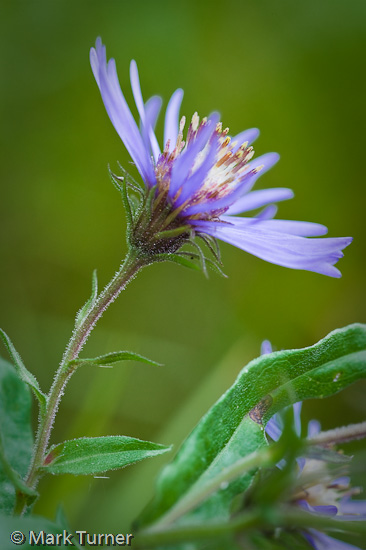Great Northern Aster

Late summer is getting toward the end of the wildflower season in the North Cascades. There’s not a whole lot still blooming after the long dry summer except the asters and goldenrod. Last weekend Natalie and I went up to Colonial Creek on Diablo Lake to camp for a couple of nights and have a little relaxed time together in the woods.
While poking around at the edge of Diablo Lake near the campground we found purple asters blooming. At first, they all looked the same. On closer examination we found there were three species. One of these was the Great Northern Aster pictured here.
 Great Northern Aster, Canadanthus modestus (formerly known as Aster modestus), is unique among the purple asters with very glandular stems and involucral bracts. That last term, for the uninitiated, means the little leaf-like things at the base of the flower head. On this species, the bracts are fairly long, sharply pointed, curving outward, and purplish in color. That makes them pretty distinctive. The stem and involucre are both noticably sticky to the touch, an easy way to tell if a plant is glandular.
Great Northern Aster, Canadanthus modestus (formerly known as Aster modestus), is unique among the purple asters with very glandular stems and involucral bracts. That last term, for the uninitiated, means the little leaf-like things at the base of the flower head. On this species, the bracts are fairly long, sharply pointed, curving outward, and purplish in color. That makes them pretty distinctive. The stem and involucre are both noticably sticky to the touch, an easy way to tell if a plant is glandular.
Great Northern Aster grows in moist places. We found it just a few feet back from the edge of Diablo Lake between the woods and the gravel beach. These photos were made at the moist edge of Thunder Lake, which is the pond between Hwy 20 and Thunder Knob just west of Colonial Creek.
I’d often wondered what the shore of Thunder Lake was like, but never had time to stop and hike the short distance down to it until this weekend. There’s no trail around the lake, which was a disappointment. I thought I could walk in the shallow water at lake’s edge, but my feet quickly sank ankle-deep in the muck and I decided that wasn’t a very good idea.
Besides the asters, we found foliage of marsh cinquefoil, yellow pond lily, a nice grass we couldn’t identify in Pojar & Mackinnon’s Plants of the Pacific Northwest Coast, and on a fallen Douglas-fir log extending out into the pond were numerous carniverous sundews. At the south end were some large rushes, but we didn’t get close enough to ID them. The only plant I photographed was the aster, which I hadn’t seen up close for several years.
After getting tired of trying to identify plants I decided the lake was warm enough for a swim, so I stripped off and dived in off the log. The water was a perfect temperature and I swam to the opposite side of the lake and back, returning refreshed and relatively clean for the drive home.

